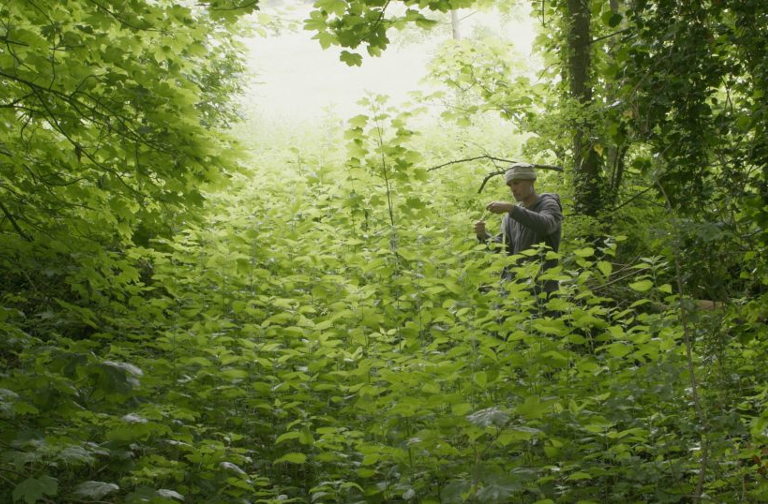Ed. note: The following piece is reposted from the Dark Mountain project with the permission of the author. Photos reused with permission of the editors.
Industrialisation began in Britain with the invention of the spinning jenny and power loom. Like a widdenshins fairy tale, these mechanisations spread across the world, from the ‘satanic mills’ of England to the colonial wool, cotton and silk industries. Now we wear and use cloth spun from oil and coloured with chemical dyes. But it wasn’t always like this. In the first post for Our Dark Materials series, textile artist Allan Brown rediscovers the magical and painstaking art of making clothes by hand from wild plants in his local Sussex woods.

Oonagh Brown wearing the nettle dress, Stanmer Woods, near Brighton, East Sussex (photo: Mark Carroll.)
The first maker in our new series, in common with the other artists we’ll be featuring, combines skilful craft with rich ideas, mythos and logos, in the work of his hands. Allan Brown spent seven years weaving fibre from that most ubiquitous of waste land plants – the stinging nettle. This mythic endeavour was enhanced by his decision to make a nettle dress, after being inspired by the folk tale ‘The Wild Swans’. Working from the ground up, both with materials and with the long acquisition of the skills needed to work such a hardy plant fibre, he has made a garment fit for his ancestors. Splicing together the earthiest ingredients from within walking distance of his home, spinning took place in the interstitial moments of his life and eventually wove his creative intention into something at once wonderful and completely down to earth. Read on, as nettle is transformed in this tale from midden weed to a maiden’s ‘weeds’ (the ancient Old English term for a dress or garment). CR
Gathering the plants
Once lost upon
the stormy Downs,
I had a vision
of a gown
That clothed a creature,
wild and free,
whose soul was full
of mystery.
Her form was shaped
by golden threads,
spun by the living
from the dead.1
I had no background in textiles, nor had I even thought much about cloth and clothing, before I became entangled with nettles. But while twisting up simple cordage from nettle bast (the outer skin or bark of the plant) on walks through the countryside, I discovered and became enamoured by the silky, fine fibres that unsuspectingly lay hidden within.
I wondered whether this fibre had ever been used to make cloth, and if so, how was this done. I had many questions but couldn’t find any answers, and there were no extant remnants of woven nettle cloth that I could track down to hold and examine. It soon became apparent that if I wanted to feel nettle cloth, I would have to make some myself, and the idea of creating a garment entirely from materials I could gather from within walking distance of the house began to take hold.
Thus set in motion years of experiments, trying to work out how best to get the fibre separated from the rest of the plant matter. I looked to the Nepalese, who have a long tradition of working with allo or Himalayan nettle, and I looked into flax and hemp, to see if there were clues in how they were traditionally processed and whether any of those methods could be applied to our wild nettle (Urtica dioica).
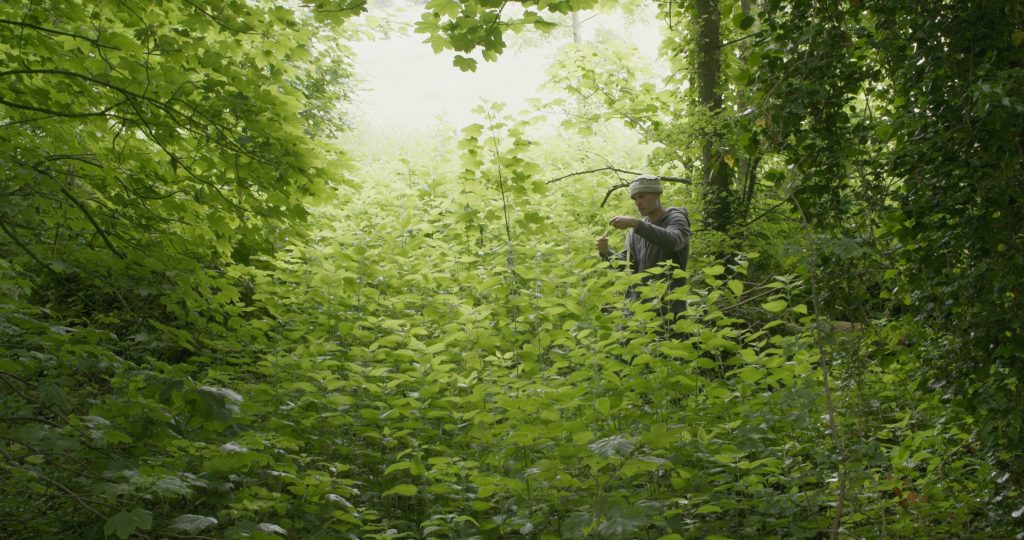
Collecting nettles in the woods, East Sussex
The Nepalese method, of boiling or cooking the nettle bast in wood ash and drying the fibres in clay, just didn’t seem to work. So I borrowed from flax and hemp processing and experimented with ‘retting’ the plants – an old word for ‘rotting’ – where you create the conditions for natural microorganisms in the soil, air and water to begin breaking down the plant and dissolving the pectin and gums that hold the outer bast to the inner woody core of the plant.
The steps in flax and hemp processing – retting, drying, breaking, scutching, bunching, hackling and finally spinning – nearly all apply to nettle too, but nettle is more resistant to mechanisation. It demands that most of these steps are carried out completely by hand. Unlike flax and hemp, nettle has a much rougher outer bark, which needs to be scraped away or removed in order to free its fine fibres. This is probably why nettle has never successfully cut it as a commercial fibre crop, despite many attempts to do so.
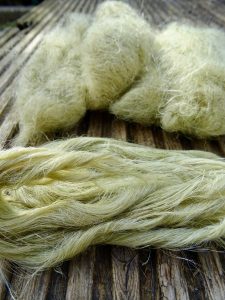
Nettle line fibre (from scraping, in the foreground) and nettle tow (from carding) in the background
To the romantics amongst us, it feels as though nettle has resisted industrialisation and is steadfastly pointing the way back to an older way of doing things – folk cloth as opposed to commercial cloth. To me it is ‘the fibre of the landless’, the most readily available high quality textile fibre that grows wild and can be easily foraged. Moreover nettles thrive in the waste left by humans and their domesticated livestock, and as well as fibre they give us medicine and food. The relationship between ourselves and nettles is an ancient one.
Over time I began to achieve a consistently clean fibre, using blunt table knives for scraping the bast and wool carders to separate out and align the fibres and remove any unwanted plant material remaining. Hemp, flax and Himalayan nettle produce very long fibres, but in using the retted fibre method I learned that our wild nettle ends up producing a much shorter staple length fibre. So I experimented by stripping the bast off freshly harvested nettles and scraping away at it until I got down into the fibres. They were indeed longer and stronger, but felt wiry, and had to be spliced and plied, as opposed to spun – the method the ancient Egyptians used to create the thread for their astonishingly fine linen cloth. I found them much harder to work with, so returned to the fluffier, shorter fibres I got from retting.
Spinning the thread
This thread is not born
of gold or from riches,
but raised in the mud
and the dirt and the ditches.
It’s both food for the hungry,
and cloth for the poor,
and has been for always
and forever more.
I had started to pick up spinning, practising on wool that I gathered from fences and bramble patches. I was mainly spinning on a drop spindle, as I loved the simplicity and portability of this wondrous tool. I spun whenever I could, often in all the little gaps of daily life – like waiting for the kettle to boil, or waiting at a bus stop. All these little moments were turned into yarn. It soon felt so natural and timeless it was almost as if my fingers had been genetically trained to do it, and in doing so it felt like my internal life was somehow being drawn out of me and recorded in the thread.

Allan spinning by the fire
I could see the fineness and quality of thread I was spinning was improving, but I had no idea how fine the thread needed to be in order to create a cloth fine enough to comfortably wear. I was keen to start weaving some samples to actually know what a nettle cloth, woven of my spun threads, would feel like.
Through our local Guild of Weavers, Spinners and Dyers I picked up a small four-shaft table loom, on which I was able to weave my first rough nettle cloth samples – they were thick, rough and unusable for clothes, but nevertheless they were a fabric of sorts and the cloth felt incredibly strong. I felt hope that as my processing improved, I would soon be spinning a thread fine enough for clothing. Sample by sample the quality of cloth I was producing was improving, and I started to manually soften up the woven cloth by pressing it with a heavy stone, which dramatically improved the softness and handle of the fabric.
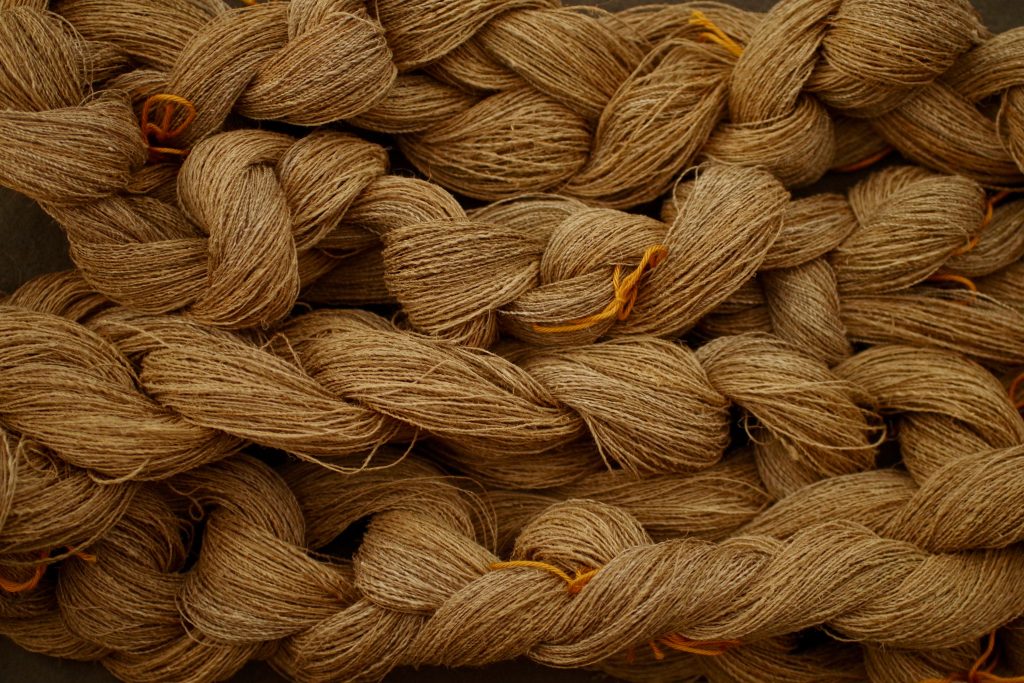
Plied nettle and flax warp threads
The threads took me not only into the land but connected me with other textile and nettle enthusiasts. Spinning introduced me to the Woolly Umbrella, a Brighton-based spinning/fibre/textile collective. My old friend Dylan Howitt, a filmmaker, shot a short ‘how to’ video we called ‘Nettles For Textiles’ that was watched online by millions. I also co-created a Facebook group and a website called ‘Nettles for Textiles’ 2 with fellow nettle explorers where the best papers, research and references to date could be stored, like a community science program. Collectively researching and sharing our findings with each other could cover far more ground together than we could individually.
Weaving a fairy tale
The warp threads held strong,
not a single one tore,
the weft lay down sweetly,
with barely a flaw.
Over and under,
a weave wove of spells,
for lovers and pilgrims
to old holy wells.
As my woven nettle samples improved, I began to think about creating an actual garment and calculating exactly how much yarn I would need to make it. Influenced by the fairy-tale nature of the whole enterprise and more specifically the Hans Christian Anderson story ‘The Wild Swans’ – in which a girl weaves a series of nettle shirts or cloaks to undo an enchantment and free her eleven brothers, who had been turned into swans – I decided that I would make a dress: a dress of nettles for the girl in the story, who felt like my muse or daimon, but made to be worn by one of my daughters. I felt that nettles had been used in that story, as opposed to the more ubiquitous flax, because there must still have existed a folk memory of using nettles and the additional labour they require. It was the fibre by which her levels of dedication and intention could be gauged. That practical wisdom, captured in a story, was very useful, in that I was able to see that perhaps there wasn’t some step in the process I was missing, that would make processing nettles as easy as flax or hemp.
I needed to get hold of a bigger loom and practise on that, in preparation for weaving the cloth that the garment would be made from. When I got hold of a large four-shaft floor loom, I began to learn this workhorse’s quirks and it taught me how to weave.

Weaving at the loom at night
It became clear that the spinning was the bottleneck in the process of creating cloth this way and highlighted how much time our ancestors must have dedicated to it. Compared to the spinning, the weaving and sewing of garments is relatively quick.
I began to look into simple dress patterns with very little wastage, so I wouldn’t have to weave an inch more than necessary. I also signed up to an adult sewing class and learned some rudimentary sewing and pattern cutting skills. I knew I would hand sew the dress, so although I learned to use a sewing machine, I practised by stitching together some of my nettle samples with a homespun thread made from a ply of nettle and flax.
Stitching the dress
So I laid out that dress,
in old Rocky Clump.
on the fallen great stone,
by the moss-covered stump.
I turned and walked out,
through the soft autumn light,
I walked until Stanmer
fell right out of sight.
By the time I’d spun enough nettle yarn to attempt weaving the cloth (14,400 ft of thread for the warp alone) I’d been spinning for about seven years. Much of the early yarn was used up in the weaving of samples and through some of those years my spinning amounted to just a few minutes a day, as I tried to fit the project around life, but everyday there was a slow sense of progress, measured out in inches of spun thread.
Finally the warp went onto the loom and the weaving of the nettle cloth proper began. Despite all my fears, the warp held good and inch by inch this wonderful cloth began to appear. Woven in plain cloth, the simple structure highlighted the slightly differing shades of yarn, harvested and spun in different seasons. It was as if all the single narrative threads were becoming material – quite literally – like the thoughts, feelings, birdsong, weather and conversations that had been spun into the yarn were now laying together, over and under each other, telling a fuller story as woven cloth.

Woven nettle cloth
Dylan, meanwhile, continued to film all the various steps that would lead to the finished dress through the hours of filming, both out in the landscape and in the weaving room. Our conversations touched on many things, and the weaving and the documenting progressed hand in hand. While I was working with physical threads on the loom, Dylan was weaving together threads of narrative that would run through the film like the warp threads on a loom or paths through a landscape. The making of the film was woven into the cloth just as the making of the cloth was woven into the film. The two crafts ran parallel to each other, in differing mediums but strangely akin.
By the time the cloth was woven and off the loom, I had sewn several toiles of the dress, refining the pattern and trying to master the godets and gussets the pattern required, in order to turn flat cloth into a comfortable three-dimensional, wearable garment. I delayed the inevitable cutting of the nettle cloth by scouring it and then softening it by pressing it between a beach stone and a wooden board – the old rock and a hard place.
Cutting the cloth was somewhat terrifying. I’d imagined this moment so many times over the years, but luckily the cloth didn’t fray as badly as I had feared, as I imagine the stone flattening step had slightly felted the fibres together. Over the course of a few weeks the dress was hand stitched together. It was as if the cloth was coming alive, taking on a human form. Occasionally I’d catch the dressed mannequin from the corner of my eye and for a moment it felt like the girl from the fairy tale had stepped out of the page and into the room.
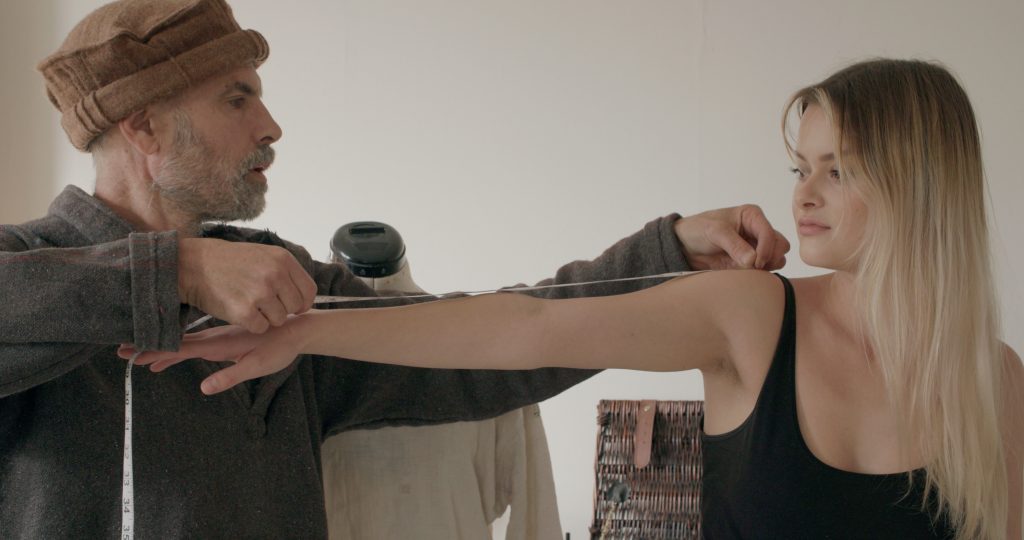
Allan measuring the dress with his daughter Oonagh.
My younger daughter Oonagh modelled the dress and the final scenes of the film are her wearing the dress back in the woods where most of the nettles had been collected. It still feels unreal, like a fairy tale, that with fairly rudimentary skills, but a lot of perseverance, a garment can be made from nettles. That a plant that stings you and tries to keep you away, can, with time and patience, be fashioned into a garment that protects you from stings and scratches, feels magical – almost unbelievable really!
The dress is finished, the film The Nettle Dress is out in the world and weaving a magic of its own, but the annual cycles roll round and another nettle season is upon us. The flax has been sown up the allotment, the dye garden tended and the annual rhythm of sowing, foraging, gathering, processing, spinning and weaving continues. The seasons and plants determine the work that needs to be done and the order it needs to be done in.
Making clothing this way is slow and gentle. It means returning to the same places and doing the same things over and over. The repetitiveness of so many of the tasks that go into creating cloth feels like a deepening rather than drudgery. It’s as if the cloth is ensouled by intention. Clothing that is being made this way, specifically for you, by people that know and love you, from fibres that are to be found in your own landscape, is the way clothing has been made for most of our history. We were collectively wearing the dreams, stories, joys and suffering of the people that made up our community. I feel that it is imperative that we reclaim the making of our clothes – slow, gentle, beautiful clothes.
Find out more about Allan’s work @hedgerowcouture
The Nettle Dress https://www.nettledress.org/
1. Verses excepted from the longer poem ‘The Nettle Dress’ by Allan Brown
2. I set up a Facebook page called ‘Nettles for Textiles’ together with my friends Gillian Edom (author of the definitive history of nettle fibre for textiles, From Sting to Spin) and Brigitte Kaltenbacher, a fellow nettle enthusiast. Collectively researching and sharing our findings with each other we could cover far more ground together than we could individually. The group is currently over 23,000 strong and producing some amazing nettle textiles, with many different processing techniques being utilised.


